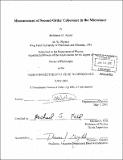Measurement of second-order coherence in the microlaser
Author(s)
Aljalal, Abdulaziz M., 1966-
DownloadFull printable version (15.25Mb)
Other Contributors
Massachusetts Institute of Technology. Dept. of Physics.
Advisor
Michael S. Feld.
Terms of use
Metadata
Show full item recordAbstract
We study the output and the degree of the second-order coherence fmunction for a microlaser in which the average number of atoms inside the cavity mode is larger than one. Two configurations of the microlaser are explored. In the standing-wave configuration, the atom-cavity coupling strength has a large variation depending on where an atom is injected in the cavity standing-wave mode. On the other hand, for the traveling-wave configuration, the atom-cavity coupling is constant along the cavity mode axis. The difference between the behavior of the microlaser for these two configurations can be attributed to the difference between their gain curves. The experimental results from our many-atom microlaser agree well with the predictions of the single-atom microlaser theory. This is anticipated because the average time an atom spends in the cavity mode is much smaller than the lifetime of a photon'in the cavity mode. As byproduct of this research, two experimental techniques are developed: a new velocity selection scheme for the barium atomic beam and a new simple multi-stop time-to- digital converter (MSTDC). Using two .dye lasers, a narrow velocity ground-state barium atomic beam is prepared. It has a velocity width of about 10% and a height of more than 50% of the original effusive atomic beam. The design of the MSTDC is based on a fast first-in-first-out (FIFO) memory. The implemented version provides stop times for any photons separated by more than 20 nsec and its range can be varied from 5 jisec to 0.66 msec.
Description
Thesis (Ph. D.)--Massachusetts Institute of Technology, Dept. of Physics, 2001. Includes bibliographical references.
Date issued
2001Department
Massachusetts Institute of Technology. Department of PhysicsPublisher
Massachusetts Institute of Technology
Keywords
Physics.